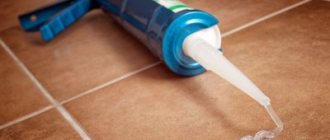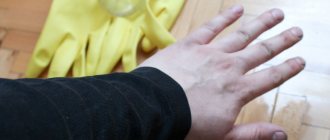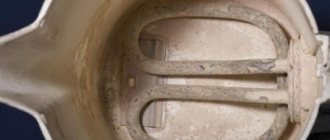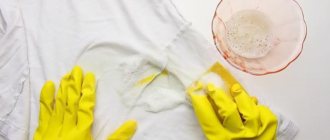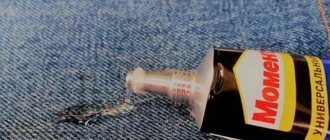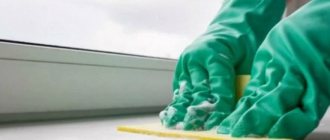A lot of internet searches are "What can I use as a polyurethane sealant remover?" This is due to the widespread use of such sealant in everyday life and in production. He has a set of unique qualities for which he is deservedly appreciated. But, along with this, the sealant has one significant drawback - it is very difficult to remove the old polymerized layer. The reason is the sealant’s unusually high ability to adhere to any material and resistance to aggressive liquids. This leads a large circle of users to the question “What should we do to remove highly resistant material that has become unnecessary?” Only a special polyurethane sealant remover can handle this task.
Self-vulcanizing polyurethane sealant is a composition based on rubbers from the class of polysulfide polymers (thiokols), used in the form of a paste or viscous mixture for the purpose of sealing seams, sealing cavities, and filling various kinds of cracks and cracks. It was invented by German scientists in the first half of the 20th century, and since then has conquered the world with its effectiveness. When used correctly, after complete crystallization, the composition becomes especially resistant to mechanical stress (punctures, scratches), to the action of solvents and other chemical liquids.
Polyurethane sealant can serve for a very long time - up to 50 years, but sooner or later, there comes a time when it is necessary to dismantle the old layer due to repairs or for another reason. It is then that the understanding comes that for ideal sealing properties, for stickiness, plasticity and strength, which have no analogues, it is necessary to pay with unsuccessful attempts to remove unnecessary mass, which has actually turned into a kind of stone. And, most often, it is not possible to do this without damaging the part or the surface being cleaned.
How to remove polyurethane sealant from hands?
How to clean polyurethane glue: list of available products
- Acetone (can be replaced with nail polish remover).
- Plastic bag.
- Ethanol.
- Vinegar 3%.
- Vegetable oil.
- Washing powder.
- Salt.
- Pumice.
Interesting materials:
How does a capacitor work in an electrical circuit? How does a capacitor work in a circuit? How does an air conditioner work without an external unit? How does a lock nut work? How does an LED strip controller work? How does an oblique hood work? How does the Mayevsky tap work on a heated towel rail? How does crop factor work? How does a plant lamp work? How does a motion sensor lamp work?
Review of popular removal methods from various surfaces
All types of sealants are chemicals. Once they get on a surface, they can be difficult to remove. At the same time, they are removed from each material differently. For example, if it gets on furniture, you cannot wash it off with a solvent. It will dilute the paint that covers the furniture.
When sealant gets on your hands, you need to wash it off as soon as possible. It is toxic and dangerous. But how to wash sealant off your hands? There are many methods. Here are some of them:
- Mechanical. Their role is that we remove the sealant from our hands by cleaning it with some hard object.
- Chemical. They wash away various substances well. To wash the sealant from the skin, you can use Penta-840 solvent. There are also special products for this purpose - Lugato Silber Shutz Silicon, Antisil, Silicon-Entferner, Dow Corning OS-2.
- Household methods. For example, a fresh mark can be wiped off with a wet cloth and then washed with soap. Or, wash off with washing powder.
- Folk remedies. This could be soap and a plastic bag, pumice stone, solvent, vinegar, sunflower oil. All this can be in the house.
Mechanical
They are perhaps the simplest. You can clean your hands of silicone sealant like this: take a sharp object and remove the plaque from the skin. Do this carefully so as not to get hurt. Tearing off the crusty substance can cause irritation, so after this procedure, be sure to wash your hands with soap and apply cream.
Important: Polyurethane sealant that has already hardened can only be cleaned this way. Since it is resistant to various solvents, they will not be very effective.
Chemical
There are many chemicals available to remove sealant from your hands. You can use special products for this - Lugato Silber Shutz Silicon, Dow Corning OS-2, anti-silicone, Silicon-Entferner.
Can sealant harm the skin?
The degree of harm of sealants depends on their composition. The comparison table will tell you about this.
| View | Harmful after contact with skin | Other problems |
| Silicone | Almost safe, but sometimes causes allergies (itching or rash) | It sticks firmly to the palms - when removed, you can injure the skin. Acetic acid fumes cause irritation of mucous membranes |
| Acrylic | Almost safe, but may cause an allergic reaction | Vinegar fumes are also typical here. |
| Polyurethane, polysulfide | Harmful due to the high acetic acid content (causes burns) | Harmful if inhaled (risk of poisoning). Always work with such sealants wearing gloves and a respirator, and the room is well ventilated |
Each sealant becomes completely safe after drying. Until this happens, safety precautions must be observed. Gloves are an important requirement, and a respirator won’t hurt either. Simple gloves from a hardware store will protect your palms from the dangerous effects of the sealant and prevent it from sticking to your skin.
When you don't have gloves, you can just soap your hands. A “protective layer” of foam prevents sealant (and other similar substances) from entering the skin pores. It is also possible to interact with silicone and acrylic sealants without gloves, periodically wiping your hands with a rag.
Is it difficult to remove sealant?
Fresh composition that has not yet had time to harden is relatively easy to clean. There are 2 ways to deal with it:
- washing hands in warm running water;
- with a damp cloth.
If the substance has time to “seize” and harden, then removing the residue will be much more difficult. Silicone sticks the strongest, but polyurethane (spray foam) and acrylic options also stick firmly to your hands. You just shouldn’t tear them off - this causes discomfort, pain and damage to the skin.
Advantages of the composition
Polyurethane sealant is an elastic, adhesive emulsion with high elasticity. It can be used on absolutely different surfaces - metal, plastic, wood, tiles, etc. The main positive aspects of the product include:
- strong and tight connection;
- the composition is not subject to cracking;
- possibility of repair and restoration;
- does not corrode;
- quick drying and hardening;
- the ability to maintain the created shape, which allows you to apply the mass on inclined surfaces;
- maintaining original characteristics for a long time.
Home Remedies
At home, removing stains from sealant is much more difficult, but it is possible. There are several cleaning methods. Acid-based construction products can be removed from clothing using concentrated acetic acid 70%. To do this, you need to soak the stain for 30 minutes, then remove the silicone with a rag or brush. The disadvantage of this method is the pungent odor that does not disappear after a single wash.
Alcohol or vodka denatures the silicone; leaving a rag soaked in alcohol for an hour will allow you to easily remove silicone from the fabric using light mechanical pressure on the stain.
If the fabric stretches well, then you can clean it without foreign agents. Stretching the area with sealant, prying up the loose pieces of film. Another effective method is freezing. Many sealants do not tolerate low temperatures well and, after freezing, crumble and are easily peeled off the surface of the material.
To clean delicate fabrics, it is better to use baby soap. Wash the area with silicone thoroughly and leave for half an hour, then wash off the stain from the clothes. This procedure will have to be carried out several times, but you don’t have to worry that aggressive products will damage your favorite jeans.
How to wash off
When it becomes impossible to avoid contact with and hardening of a chemical on the skin, it is necessary to take measures to remove it. There are several ways to remove traces of glue at home.
Mechanical method
You can wipe off the frozen product mechanically. It involves cutting or tearing off the top layer of a chemical product with a sharp tool. Mechanical removal may leave painful lesions on the skin.
After this method, it is necessary to thoroughly treat the damaged areas on your hands with a disinfectant.
Soap and plastic bag
To wash the glue off your hands, you can use a simple removal method using a plastic bag and a bar of soap. You should take the bag in your hands and rub the contaminated areas with it. The glue will stick to the polyethylene, so the skin can be easily cleaned of the chemical. The procedure should be repeated until the skin is completely cleansed. After this, hands are soaped and washed under running water.
Solvents
A quick and effective method is to treat your hands with degreasing agents. Most solvents have a strong odor and are highly toxic.
Important: it is recommended to treat your hands with solvents in a well-ventilated area or in the fresh air.
Acetone
If a little time has passed since the contamination, you can remove the hardened silicone with an aggressive solvent. Soak a cotton pad in acetone and wipe the contaminated area.
After manipulation, you must wash your hands with soap and lubricate them with protective cream.
White Spirit
White-spirit can effectively cleanse stains. To do this, soak a lint-free cloth in the solution and treat the stained skin. After 2-3 minutes, the solution is washed off and hands are washed in soapy water.
Alcohol
To cleanse the skin, you can use 90 percent alcohol. Use a cotton swab soaked in alcohol to thoroughly wipe the frozen glue. Do not rub for a long time so as not to dry out the skin.
After the procedure, hands are washed in warm water and soap and lubricated with a rich cream.
Vinegar solution
To prepare the solution, take vinegar and water in equal proportions. Then wipe your hands with the resulting liquid, everything is washed off with soapy water. It is recommended to take laundry soap. It will wash away the remnants of the vinegar solution without leaving a trace.
Vegetable oil and washing powder
The skin of the hands is wiped off from the mounting adhesive with sunflower or other vegetable oil. The procedure is performed as follows:
- take half a glass of oil;
- heated in a water bath;
- Add washing powder to the oil container;
- Use the mixture to wipe the stained areas.
After thorough treatment, hands are washed in running water.
Removal wipes
Hardware stores offer disposable wipes for removing hardened installation fluids. They are impregnated with a special solution that removes glue on different bases well.
After completing the repair work, you should wipe your hands well with napkins and rinse in warm water.
What is sealant and how to remove it
A sealant is also a paste or viscous mixture based on polymers or oligomers, applied to bolted, rivet and other joints for the purpose of sealing. After repair work, it is necessary to completely clean the surfaces and crevices from residual mixtures - cement, glue and sealant. Especially a sealant that darkens with prolonged use or comes off. It is also more difficult to remove from glass and cracks. But from the instructions you can find out: – What can you use to wipe off the sealant?
Why do you need a polyurethane coating?
Polyurethane coatings reliably protect surfaces from mechanical and chemical influences. They can process concrete, brick, tiles, slate, etc. The composition can be applied at temperatures from -30 degrees. The surface humidity should be no more than 5%. Main advantages of coatings:
- resistance to moisture;
- long service life;
- ability to withstand sudden temperature changes;
- environmental friendliness;
- resistance to microbial development;
- ease of use.
Frost-resistant characteristics allow you to work with coatings even at sub-zero temperatures.
Why do you need a polyurethane coating?
Polyurethane coatings reliably protect surfaces from mechanical and chemical influences. They can process concrete, brick, tiles, slate, etc. The composition can be applied at temperatures from -30 degrees. The surface humidity should be no more than 5%. Main advantages of coatings:
- resistance to moisture;
- long service life;
- ability to withstand sudden temperature changes;
- environmental friendliness;
- resistance to microbial development;
- ease of use.
Frost-resistant characteristics allow you to work with coatings even at sub-zero temperatures.
Types and chemical composition
Modern industry produces two types of these coatings - on a one-component and on a two-component basis. The first type can be used immediately after purchase. It's quite liquid. You can find such materials in aerosol packaging.
Polyurethane two-component varnish consists of a base and a hardener. Before use, these components are mixed in certain proportions specified by the manufacturer. Two-component varnish is used primarily on large surfaces. It is worth mixing very carefully - the mixture does not lose its properties for 4-5 hours.
Based on the result after drying, glossy and matte varnish can be distinguished; semi-matte and semi-gloss materials are also offered. There are compositions that have self-leveling properties.
In terms of the quality of adhesion to different materials, the glossy and matte versions of the varnish are not particularly different. However, due to the gloss, scratches and signs of damage are clearly visible. It is better to use such compositions on surfaces that are not subject to strong mechanical stress.
Polyurethane matte varnish looks better in rooms where daylight is diffused. Also, matte surfaces hide various defects and the consequences of unskilled application much better.
Water based varnish
Water-based polyurethane varnish has a dry residue of at least 40% substances, due to which its cost is reduced when compared with solvent-based paints and varnishes. This varnish can withstand exposure to direct sunlight and has high strength and ductility. The composition is not afraid of exposure to water, temperature changes, the film after drying has a high level of wear resistance. After severe impact loads, no cracks appear on the surface.
To reduce cost, different manufacturers can dilute the composition with acrylic. This product belongs to the group of acrylic-polyurethane coatings. Due to the reduced price, polyurethane-based acrylic varnish has low performance characteristics.
The surface will look transparent after drying. The product has no color. This way you can effectively highlight the beauty of natural wood or stone.
It is important that water-based compounds do not turn yellow over time. The product is completely safe for people and pets, non-toxic
Wear resistance is slightly lower than most other varnishes, but this material dries much faster. To ensure that the film adheres well to the surface, it is recommended to apply three layers. For varnishing, the temperature regime should be taken into account - 20-23 degrees. It is undesirable to carry out work at temperatures of +13 degrees and +30. If the room humidity is high, drying time may be affected. The ideal humidity for this paintwork is 55%-60%.
Advantages of the composition
Polyurethane sealant is an elastic, adhesive emulsion with high elasticity. It can be used on absolutely different surfaces - metal, plastic, wood, tiles, etc. The main positive aspects of the product include:
- strong and tight connection;
- the composition is not subject to cracking;
- possibility of repair and restoration;
- does not corrode;
- quick drying and hardening;
- the ability to maintain the created shape, which allows you to apply the mass on inclined surfaces;
- maintaining original characteristics for a long time.

